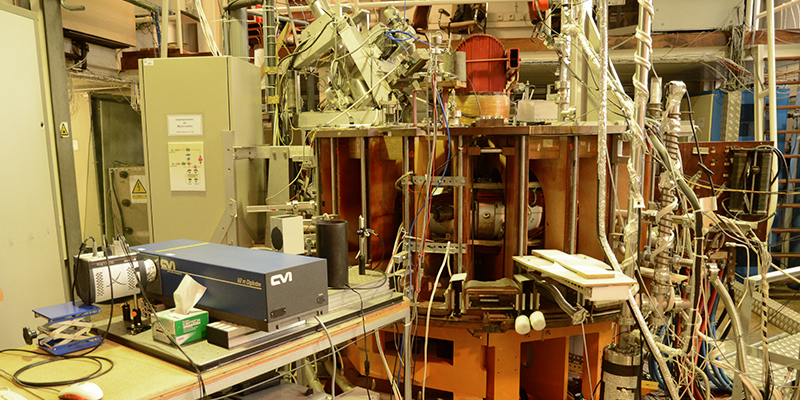ISTTOK - Wiki
IST Tokamak - ISTTOK
Índice
Description
The ISTTOK Tokamak ("Instituto Superior Técnico TOKamak") is a research fusion reactor (tokamak) of the Instituto Superior Técnico.
The ISTTOK Tokamak ("Instituto Superior Tecnico TOKamak") is a research fusion reactor (tokamak) of the Instituto Superior Tecnico. It has a circular cross-section due to a poloidal graphite limiter and an iron core transformer. This magnetic confinement experiment has been built from some components (supporting structure, vacuum chamber, copper shell, transformer, toroidal magnetic field coils, radio-frequency generator, and capacitor banks) of the ex-tokamak TORTUR which was de-commissioned by the Association EURATOM/FOM in 1988.
Goals and research objectives
The scientific programme has been based on:
- Edge plasma turbulence studies;
- Operation and control on alternating plasma current regimes;
- Testing of liquid metal limiter concept;
- Development and upgrade of diagnostics;
- Test bed facility for new data acquisition concepts and hardware.
Theory contribution
Understanding turbulent transport is important to optimize the plasma confinement and for predicting the performance of future devices. Research on the comprehensive investigation of the multi-scale physics aspects of the edge turbulence, from its origin to the impact on transport including plasma-wall interaction. ISTTOK is ideal for edge physics studies due to its flexibility, low operation costs, short time scale for diagnostics implementation and compatibility with electrostatic probes. The universality of several edge physics phenomena was verified in different devices, confirming the relevance of these studies in small devices. Present activities include:
- Contribute to a better understanding of spontaneously generated large-scale sheared flows and its role in regulating plasma transport.
- Characterize and control the SOL intermittent transport.
- Develop different electrical probes systems for edge studies.
- Provide synergies between theory and experimental groups working on edge/SOL physics.
- Develop analysis tools required to process the massive experimental data obtained .
Diagnostics development
Further studies on the ISTTOK plasma emissivity reconstruction using analytical methods, aiming at the best choice for real-time implementation in ISTTOK. Upgrade existing tomographic cameras to 3 x 16 channels in order to improve spatial resolution for enhanced emissivity reconstruction. Developing and building a retarding electrostatic field cylindrical energy analyzer (CEA) to measure plasma potentials in the core and their fluctuations.
Main experimental achievements
AC operation
Due to iron core saturation, operation of ISTTOK in single pulse mode is limited to 35 ms plasma duration. ISTTOK has suffer a major update of its control systems and power supplies to operate in AC mode increasing that parameter to more than 1000 ms. Within this line of research present activities include:
- Operation of the tokamak ISTTOK in a multi-cycle alternating plasma current regime, to obtain long duration discharges.
- Implementation of a real-time plasma control system and study of the control of long duration AC discharges in ISTTOK.
- Development of advanced gas feed control to improve reproducible and reliable plasmas with high performance.
Testing of liquid metal PFC
Liquid metals as PFCs
One of the most challenging issues with regards to the operation of a future fusion reactor is related to plasma-wall interaction. Solid materials exposed to fusion plasmas are known to suffer significant damage that reduces wall lifetime. Liquid metals have proven to be of relevance for PFC protection. Due to ISTTOK characteristics its programme has also focused on testing liquid metals PFC´s and their properties:
- Develop a novel Liquid Metal Limiter based on micro-channels structures.
- Build and test the new LML concept using gallium as liquid metal.
- Expose this PFC to ISTTOK plasmas.
- Study the behavior of the limiter surface temperature increase with liquid metal re-circulation.
Data acquisition and control
Implementation of a control system based on an optimized state-space model for real time control of the plasma current magnitude and centroid position retrieved by a twelve mirnov coils poloidal set.
Physical parameters
Nominal plasma parameters
Precedents
TORTUR
Tortur was a tokamak designed in Grenoble with an initial primary to secondary winding ratio of 1:1, as the stabilizing cooper-shell was used as well as the primary. A very high current had to be feed in this primary and short discharges were obtained (up to 8 ms). The stainless steel 625 vessel was divided in two C-sections and equiped with 33 ports of 35mm, constructed by Avica Equipment, England. Basically the vessel is port structures welded together by a thin bellow of 0.15mm with an inner diameter of 200mm
TORTUR II
Tortur II undergo a vessel upgrade of the former one by the same manufacturer, assuming the actual form os ISTTOK. Besides that was equipped with a iron-core transformer with 20:1 or 40:1 transformer relation.
ISTTOK@XX
After the commissioning in Portugal, Tortur became the IST TOKamak, ISTTOK. During XX century is was operated with two capacitors banks as it's predecessor and only with forward current. The main systems have been updated, namely the vacuum systems, the plant control systems and data acquisition. Discharges were started based on a cold plasma generated by the TORTUR RF generator but due to the high noise have been soon replaced by an electron beam source (80 eV, tungsten filament) situated on the high field side close to the SOL. The hot plasma was started by the high voltage bank (1-5kV, 100uF, 2-3ms) and then an electrolytic bank (0.8F, 350V, 40-50ms) took over.
